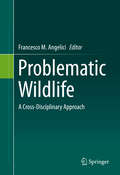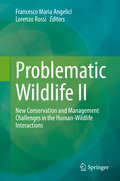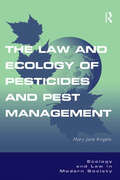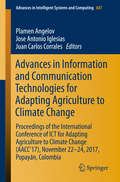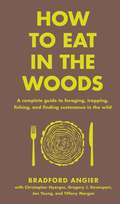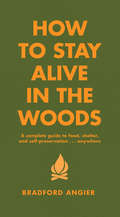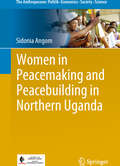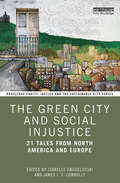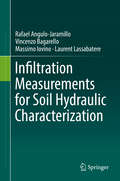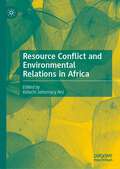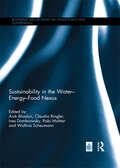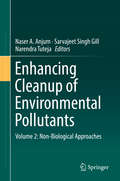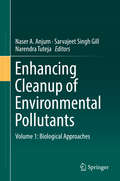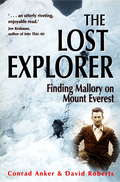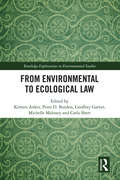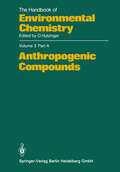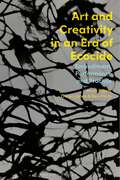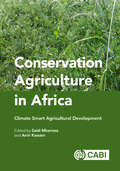- Table View
- List View
Problematic Wildlife: A Cross-Disciplinary Approach
by Francesco M. AngeliciThis book provides insight into the instances in which wildlife species can create problems. Some species trigger problems for human activities, but many others need humans to save them and to continue to exist. The text addresses issues faced by economists and politicians dealing with laws involving actions undertaken to resolve the problems of the interaction between humans and wildlife. Here, the words ‘problematic species’ are used in their broadest sense, as may be appreciated in the short introductions to the various sections. At times, the authors discuss special cases while always extending the discussion into a more general and broad vision. At others, they present real cutting-edge analysis of ecological topics and issues. The book will be of interest to biologists, ecologists and wildlife managers involved in research on wildlife, parks, and environmental management, as well as to government departments and agencies, NGOs and conservation wildlife organizations. Even those in contact with nature, such as hunters, herders, and farmers, will be able to find a great deal of important information. Specific case studies are selected from among the most significant and prevalent cases throughout the world. A total of 26 papers have been selected for this book, written by zoologists, biologists and ecologists. Many have an interdisciplinary approach, with contributions by economists, criminologists, technical specialists, and engineers.
Problematic Wildlife II: New Conservation and Management Challenges in the Human-Wildlife Interactions
by Francesco Maria Angelici Lorenzo RossiIn a world where habitats are constantly changing and the impact of anthropization on the environment is increasingly intense, interactions between human and wildlife are becoming more and more complex. Some species pose problems for human activities while many others need to be helped in order to continue to exist. This book follows the first volume called 'Problematic Wildlife', edited by F.M. Angelici and published by Springer in 2016, which has had considerable success with readers and critics. The volume includes 21 chapters divided into 7 parts devoted specific topics which are approached in a multidisciplinary way. There are both review chapters and specific cases, always bearing in mind the interest for an international audience. The book is useful both for scientists, wildlife specialists, conservationists, zoologists, ecologists, university students, nature managers, and for those who live in contact with wildlife and its problems, such as farmers, shepherds, hunters, urban planners, and staff of parks and nature reserves. Its ultimate goal is to offer scientific and pragmatic approaches to manage each categories of problematic species.
The Law and Ecology of Pesticides and Pest Management
by Mary Jane AngeloAlthough concerns over the ecological impacts of pesticides gave rise to the environmental movement of the late 1960s and 1970s, since that time, pesticide use and its effects have been largely ignored by the law and by legal scholars. This book addresses this omission by providing a unique and serious treatment of the significance of pesticide issues in environmental law and takes an ecological perspective on the legal issues. Dealing with a wide range of questions relating to pests and pesticides, the book focuses primarily on agricultural pesticide use as the largest contaminator in the US. It also examines the legacy of past pesticide use and analyzes how recent developments in ecological science can inform the law and increase our understanding of ecology. Interdisciplinary in its approach, the book will be of interest to academics, lawyers, scientists and environmental and agricultural professionals.
The Law and Ecology of Pesticides and Pest Management
by Mary Jane AngeloAlthough concerns over the ecological impacts of pesticides gave rise to the environmental movement of the late 1960s and 1970s, since that time, pesticide use and its effects have been largely ignored by the law and by legal scholars. This book addresses this omission by providing a unique and serious treatment of the significance of pesticide issues in environmental law and takes an ecological perspective on the legal issues. Dealing with a wide range of questions relating to pests and pesticides, the book focuses primarily on agricultural pesticide use as the largest contaminator in the US. It also examines the legacy of past pesticide use and analyzes how recent developments in ecological science can inform the law and increase our understanding of ecology. Interdisciplinary in its approach, the book will be of interest to academics, lawyers, scientists and environmental and agricultural professionals.
Advances in Information and Communication Technologies for Adapting Agriculture to Climate Change: Proceedings of the International Conference of ICT for Adapting Agriculture to Climate Change (AACC'17), November 22-24, 2017, Popayán, Colombia (Advances in Intelligent Systems and Computing #687)
by Plamen Angelov Jose Antonio Iglesias Juan Carlos CorralesThis book presents novel communication technology solutions to address the effects of climate change and climate variability on agriculture, with a particular focus on those that increase agricultural production. It discusses decision support and early warning systems for agriculture; information technology (IT) supporting sustainable water management and land cover dynamics; predictive of crop production models; and software applications for reducing the effects of diseases and pests on crops. Further topics include the real-time monitoring of weather conditions and water quality, as well as food security issues. Featuring the proceedings of the International Conference of ICT for Adapting Agriculture to Climate Change (AACC’17), held on November 22–24, 2017, in Popayán, Colombia, the book represents a timely report and a source of new ideas and solutions for both researchers and practitioners active in the agricultural sector around the globe.
How to Eat in the Woods: A Complete Guide to Foraging, Trapping, Fishing, and Finding Sustenance in the Wild (In the Woods)
by Bradford AngierA comprehensive, practical, and reliable guide to finding food in the woods and living off the land, by respected wilderness survivalists. With text by wilderness survivalists, the information in How to Eat in the Woods is tried, trusted, and true. One of the most complete books written on the subject, this portable guide includes essential information on how to track, trap, kill, and prepare various types of animals; select bait, land fish, and clean and cook the catch; recognize edible plants, fruits, berries, and nuts; locate bird eggs; catch edible insects; and find potable water. Also included is information on building a fire and preparing food without utensils.
How to Eat in the Woods: A Complete Guide to Foraging, Trapping, Fishing, and Finding Sustenance in the Wild (In the Woods)
by Bradford AngierA comprehensive, practical, and reliable guide to finding food in the woods and living off the land, by respected wilderness survivalists. With text by wilderness survivalists, the information in How to Eat in the Woods is tried, trusted, and true. One of the most complete books written on the subject, this portable guide includes essential information on how to track, trap, kill, and prepare various types of animals; select bait, land fish, and clean and cook the catch; recognize edible plants, fruits, berries, and nuts; locate bird eggs; catch edible insects; and find potable water. Also included is information on building a fire and preparing food without utensils.
How to Stay Alive in the Woods: A Complete Guide To Food, Shelter And Self-preservation Anywhere (In The Woods Ser.)
by Bradford AngierHOW TO STAY ALIVE IN THE WOODS is a practical, readable-and potentially indispensable-manual for anyone venturing into the great outdoors. Broken down into four essential sections, Sustenance, Warmth, Orientation and Safety, this enlightening guide reveals how to catch game without a gun, what plants to eat (full-color illustrations of these make identification simple), how to build a warm shelter, make clothing, protect yourself and signal for help. Detailed illustrations and expanded instructions, newly commissioned for this deluxe edition, offer crucial information at a glance, making How to Stay Alive in the Woods truly a lifesaver.
Thermal Safety Margins in Nuclear Reactors
by Henryk AnglartThis book presents an overview of state-of-the art approaches to determine thermal safety margins in nuclear reactors. It presents both the deterministic and probabilistic aspects of thermal safety margins of nuclear reactors to facilitate the understanding of these two difficult topics at various academic levels, from undergraduates to researchers in nuclear engineering.It first sets out the theoretical background before exploring how to determine thermal safety margins in nuclear reactors, through examples, problems and advanced state-of-the-art approaches. This will help undergraduate students better understand the most fundamental aspects of nuclear reactor safety. For researchers and practitioners, this book provides a comprehensive overview of most recent achievements in the field, offering an excellent starting point to develop new methods for the assessment of the thermal safety margins.This book is written to bridge the gap between deterministic and appropriate treatment of uncertainties to assess safety margins in nuclear reactors, presenting these approaches as complementary to each other. Even though these two approaches are frequently used in parallel in real-world applications, there has been a lack of a consistent teaching approach in this area.This book is suitable for readers with a background in calculus, thermodynamics, fluid mechanics, and heat transfer. It is assumed that readers have previous exposure to such concepts as laws of thermodynamics, enthalpy, entropy, and conservation equations used in fluid mechanics and heat transfer.Key Features:• Covers the theory, principles, and assessment methods of thermal safety margins in nuclear reactors whilst presenting the state-of-the-art technology in the field• Combines the deterministic thermal safety considerations with a comprehensive treatment of uncertainties, offering a framework that is applicable to all current and future commercial nuclear reactor types• Provides numerous examples and problems to be solvedHenryk Anglart is Professor Emeritus of Nuclear Engineering at the KTH Royal Institute of Technology, Stockholm, Sweden, and at the Warsaw University of Technology (WUT), Warsaw, Poland. He received his MSc from WUT and his PhD from the Rensselaer Polytechnic Institute, Troy, NY. After his eighteen year career as a research and development engineer at Westinghouse in Sweden, he accepted a tenure position at KTH, where he has supervised many PhD students and post-doctoral fellows, and has taught several courses in nuclear engineering. In addition to research and teaching, Prof. Henryk Anglart was serving for a long time as head of Reactor Technology Division, Deputy Director of the Physics Department, and Director of Nuclear Technology Center at KTH. Prof. Henryk Anglart authored and coauthored over 200 journals, conference and other scientific publications. He is also an author of three textbooks used in teaching of nuclear engineering courses at WUT and KTH, and two CRC Press books: Multilingual Dictionary of Nuclear Reactor Physics and Engineering, and Introduction to Sustainable Energy Transformation.
Thermal Safety Margins in Nuclear Reactors
by Henryk AnglartThis book presents an overview of state-of-the art approaches to determine thermal safety margins in nuclear reactors. It presents both the deterministic and probabilistic aspects of thermal safety margins of nuclear reactors to facilitate the understanding of these two difficult topics at various academic levels, from undergraduates to researchers in nuclear engineering.It first sets out the theoretical background before exploring how to determine thermal safety margins in nuclear reactors, through examples, problems and advanced state-of-the-art approaches. This will help undergraduate students better understand the most fundamental aspects of nuclear reactor safety. For researchers and practitioners, this book provides a comprehensive overview of most recent achievements in the field, offering an excellent starting point to develop new methods for the assessment of the thermal safety margins.This book is written to bridge the gap between deterministic and appropriate treatment of uncertainties to assess safety margins in nuclear reactors, presenting these approaches as complementary to each other. Even though these two approaches are frequently used in parallel in real-world applications, there has been a lack of a consistent teaching approach in this area.This book is suitable for readers with a background in calculus, thermodynamics, fluid mechanics, and heat transfer. It is assumed that readers have previous exposure to such concepts as laws of thermodynamics, enthalpy, entropy, and conservation equations used in fluid mechanics and heat transfer.Key Features:• Covers the theory, principles, and assessment methods of thermal safety margins in nuclear reactors whilst presenting the state-of-the-art technology in the field• Combines the deterministic thermal safety considerations with a comprehensive treatment of uncertainties, offering a framework that is applicable to all current and future commercial nuclear reactor types• Provides numerous examples and problems to be solvedHenryk Anglart is Professor Emeritus of Nuclear Engineering at the KTH Royal Institute of Technology, Stockholm, Sweden, and at the Warsaw University of Technology (WUT), Warsaw, Poland. He received his MSc from WUT and his PhD from the Rensselaer Polytechnic Institute, Troy, NY. After his eighteen year career as a research and development engineer at Westinghouse in Sweden, he accepted a tenure position at KTH, where he has supervised many PhD students and post-doctoral fellows, and has taught several courses in nuclear engineering. In addition to research and teaching, Prof. Henryk Anglart was serving for a long time as head of Reactor Technology Division, Deputy Director of the Physics Department, and Director of Nuclear Technology Center at KTH. Prof. Henryk Anglart authored and coauthored over 200 journals, conference and other scientific publications. He is also an author of three textbooks used in teaching of nuclear engineering courses at WUT and KTH, and two CRC Press books: Multilingual Dictionary of Nuclear Reactor Physics and Engineering, and Introduction to Sustainable Energy Transformation.
Women in Peacemaking and Peacebuilding in Northern Uganda (The Anthropocene: Politik—Economics—Society—Science #22)
by Sidonia AngomThe book analyses the two decades of the brutal civil war of northern Uganda. The author modified Lederach's peacebuilding framework to include peacemaking to bring out the argument that women and men make significant contributions to the peace processes and point out women’s position as top leadership actors. The book uncovers the under-emphasised role of women in peacemaking and building. From grassroots to national level, women were found to have organised themselves and assumed roles as advocates, negotiators and mobilisers. The actions by women became evident at the stalemated Juba peace talks when women presented the Peace Torch to the peace negotiating teams who on the occasion shook hands for the first time and peace was ushered in. Their initiatives and non-violent actions offer lessons to resolve civil conflicts in Africa. The book recommends that women should undergo relevant training in times of peace as this would make them more effective in times of need.
The Green City and Social Injustice: 21 Tales from North America and Europe (Routledge Equity, Justice and the Sustainable City series)
by Isabelle Anguelovski James J. T. ConnollyThe Green City and Social Injustice examines the recent urban environmental trajectory of 21 cities in Europe and North America over a 20-year period. It analyses the circumstances under which greening interventions can create a new set of inequalities for socially vulnerable residents while also failing to eliminate other environmental risks and impacts. Based on fieldwork in ten countries and on the analysis of core planning, policy and activist documents and data, the book offers a critical view of the growing green planning orthodoxy in the Global North. It highlights the entanglements of this tenet with neoliberal municipal policies including budget cuts for community initiatives, long-term green spaces and housing for the most fragile residents; and the focus on large-scale urban redevelopment and high-end real estate investment. It also discusses hopeful experiences from cities where urban greening has long been accompanied by social equity policies or managed by community groups organizing around environmental justice goals and strategies. The book examines how displacement and gentrification in the context of greening are not only physical but also socio-cultural, creating new forms of social erasure and trauma for vulnerable residents. Its breadth and diversity allow students, scholars and researchers to debunk the often-depoliticized branding and selling of green cities and reinsert core equity and justice issues into green city planning—a much-needed perspective. Building from this critical view, the book also shows how cities that prioritize equity in green access, in secure housing and in bold social policies can achieve both environmental and social gains for all.
Infiltration Measurements for Soil Hydraulic Characterization
by Rafael Angulo-Jaramillo Vincenzo Bagarello Massimo Iovino Laurent LassabatereThis book summarises the main results of many contributions from researchers worldwide who have used the water infiltration process to characterize soil in the field. Determining soil hydrodynamic properties is essential to interpret and simulate the hydrological processes of economic and environmental interest. This book can be used as a guide to soil hydraulic characterization and in addition it gives a complete description of the treated techniques, including an outline of the most significant research results, with the main points that still needing development and improvement.
Cobalt: The Making of a Mining Superpower
by Charlie AngusThe world is desperate for cobalt. It drives the proliferation of digital and clean technologies. But this “demon metal” has a horrific present and a troubled history. The modern search for cobalt has brought investors back to a small town in Northern Canada, a place called Cobalt. Like the demon metal, this town has a dark and turbulent history. The tale of the early-twentieth-century mining rush at Cobalt has been told as a settler’s adventure, but Indigenous people had already been trading in metals from the region for two thousand years. And the events that happened here — the theft of Indigenous lands, the exploitation of a multicultural workforce, and the destruction of the natural environment — established a template for resource extraction that has been exported around the world. Charlie Angus reframes the complex and intersectional history of Cobalt within a broader international frame — from the conquistadores to the Western gold rush to the struggles in the Democratic Republic of Congo today. He demonstrates how Cobalt set Canada on its path to become the world’s dominant mining superpower.
Resource Conflict and Environmental Relations in Africa
by Kelechi Johnmary AniThe book discusses the failure of many African governments in providing the social needs of the masses, thereby placing the citizenry on the desperate quest for economic resources. Unfortunately, in many African States, mineral resources are owned, explored and marketed by the machinery of the state. The problem arises when the masses begin to challenge state access and ownership of resources that are domiciled within their ancestral land, communities, and constituencies. Often the challenge and resistance to state ownership of resources is generated by communal or group sense of exploitation, negligence and widespread poverty in the face of high resource endowment and waste by the government officials. Paradoxically, in Niger Delta of Nigeria, as discussed in the book, the state has unleashed unlimited might upon all social groups and agitators, thereby leading to the increased act of taking arms by such groups. When the informal resource agitators succeed in arming themselves, they begin to demand social and environmental justice, thereby leading to mass armed conflict between them and the government security agencies. Sometimes, the confrontation could be between them and other rival local resource actors in the informal sector of their country’s economy bearing in mind that the resources within their jurisdiction have become the central determinant of national commonwealth. It is at that state of desperado to control access, extraction and sale of natural resources in a State, by different armed groups that the process of natural resources extraction qualifies as the most visible cause of conflicts and crises around the African continent that is the centrepiece of the book. This is quite understandable given that mineral resource is a gift of nature; and nature is that phenomenon that every human, group and nation claim to represent, or, believe to represent them.
Sustainability in the Water-Energy-Food Nexus (Routledge Special Issues on Water Policy and Governance)
by Anik Bhaduri, Claudia Ringler, Ines Dombrowsky, Rabi Mohtar and Waltina ScheumannIt is beyond doubt that the interconnectedness between food, energy, water security and environmental sustainability exists and is getting amplified with increased globalization. It has been recognized that efforts to address only one part of a systemic problem by neglecting other inherently interlinked aspects may not lead to desirable and sustainable outcomes. In this perspective, policy- and decision- making requires a nexus approach that reduces trade-offs and builds synergies across sectors, and helps to reduce costs and increase benefits for humans and nature compared to independent approaches to the management of water, energy, food and the environment. In the past, work related to the Nexus has looked at the interactions between water and food or water and energy, but there has been a reluctance to bring forward a broader systematic perspective that captures the multiple sectors and resource dependencies while understanding its cost to the environment if we neglect these linkages. This book is a compilation of thirteen papers published previously as a special issue of Water International, contains significant pieces of work on the W-E-F nexus focusing on relevant tools, solutions and governance at local and broader human scales.
Enhancing Cleanup of Environmental Pollutants: Volume 2: Non-Biological Approaches
by Naser A. Anjum Sarvajeet Singh Gill Narendra TutejaThis two-volume work is an effort to provide a common platform to environmental engineers, microbiologists, chemical scientists, plant physiologists and molecular biologists working with a common aim of sustainable solutions to varied environmental contamination issues. Chapters explore biological and non-biological strategies to minimize environmental pollution. Highly readable entries attempt to close the knowledge gap between plant - microbial associations and environmental remediation.Volume 2 focuses on the non-biological/chemical approaches for the cleanup of contaminated soils. Important concepts such as the role of metallic iron in the decontamination of hexavalent chromium polluted waters are highlighted; in addition, nanoscale materials and electrochemical approaches used in water and soil remediation are discussed; and the synthesis and characterization of cation composite exchange material and its application in removing toxic metals are elaborated in detail. Readers will also discover the major advances in the remediation of environmental pollutants by adsorption technologies.
Enhancing Cleanup of Environmental Pollutants: Volume 1: Biological Approaches
by Naser A. Anjum Sarvajeet Singh Gill Narendra TutejaThis two-volume work is an effort to provide a common platform to environmental engineers, microbiologists, chemical scientists, plant physiologists and molecular biologists working with a common aim of sustainable solutions to varied environmental contamination issues. Chapters explore biological and non-biological strategies to minimize environmental pollution. Highly readable entries attempt to close the knowledge gap between plant - microbial associations and environmental remediation.Volume 1 focuses on important concepts such as biological remediation strategies to enhance soil quality at contaminated sites; synergistic influences of tolerant plants and rhizospheric microbial strains on the remediation of pesticide contaminated soil, and the role of plant types such as hyperaccumulator plants in the cleanup of polluted soils. Readers will discover mechanisms and underlying natural inherent traits of various plants and microbes for tolerating, excluding, remediating, accumulating, or metabolizing a variety of pollutants.
The Lost Explorer: Finding Mallory on Mount Everest
by Conrad Anker David RobertsIn 1999, Conrad Anker found the body of George Mallory on Mount Everest, casting an entirely new light on the mystery of the lost explorer.On 8 June 1924, George Leigh Mallory and Andrew 'Sandy' Irvine were last seen climbing towards the summit of Everest. The clouds closed around them and they were lost to history, leaving the world to wonder whether or not they actually reached the summit - some 29 years before Edmund Hillary and Tensing Norgay.On 1 May 1999, Conrad Anker, one of the world's foremost mountaineers, made the momentous discovery - Mallory's body, lying frozen into the scree at 27,000 feet on Everest's north face. Recounting this day, the authors go on to assess the clues provided by the body, its position, and the possibility that Mallory had successfully climbed the Second Step, a 90-foot sheer cliff that is the single hardest obstacle on the north face. A remarkable story of a charming and immensely able man, told by an equally talented modern climber.
From Environmental to Ecological Law (Routledge Explorations in Environmental Studies)
by Kirsten Anker Peter D. Burdon Geoffrey Garver Michelle Maloney Carla SbertThis book increases the visibility, clarity and understanding of ecological law. Ecological law is emerging as a field of law founded on systems thinking and the need to integrate ecological limits, such as planetary boundaries, into law. Presenting new thinking in the field, this book focuses on problem areas of contemporary law including environmental law, property law, trusts, legal theory and First Nations law and explains how ecological law provides solutions. Written by ecological law experts, it does this by 1) providing an overview of shortcomings of environmental law and other areas of contemporary law, 2) presenting specific examples of these shortcomings, 3) explaining what ecological law is and how it provides solutions to the shortcomings of contemporary law, and 4) showing how society can overcome some key challenges in the transition to ecological law. Drawing on a diverse range of case study examples including Indigenous law, ecological restoration and mining, this volume will be of great interest to students, scholars and policymakers of environmental and ecological law and governance, political science, environmental ethics and ecological and degrowth economics.
From Environmental to Ecological Law (Routledge Explorations in Environmental Studies)
by Kirsten Anker Peter D. Burdon Geoffrey Garver Michelle Maloney Carla SbertThis book increases the visibility, clarity and understanding of ecological law. Ecological law is emerging as a field of law founded on systems thinking and the need to integrate ecological limits, such as planetary boundaries, into law. Presenting new thinking in the field, this book focuses on problem areas of contemporary law including environmental law, property law, trusts, legal theory and First Nations law and explains how ecological law provides solutions. Written by ecological law experts, it does this by 1) providing an overview of shortcomings of environmental law and other areas of contemporary law, 2) presenting specific examples of these shortcomings, 3) explaining what ecological law is and how it provides solutions to the shortcomings of contemporary law, and 4) showing how society can overcome some key challenges in the transition to ecological law. Drawing on a diverse range of case study examples including Indigenous law, ecological restoration and mining, this volume will be of great interest to students, scholars and policymakers of environmental and ecological law and governance, political science, environmental ethics and ecological and degrowth economics.
Anthropogenic Compounds (The Handbook of Environmental Chemistry #3 / 3A)
by Rudolf Anliker G. C. Butler E. A. Clarke U. Förstner W. Funke C. Hyslop G. Kaiser C. Rappe J. Russow G. Tölg M. Zander V. ZitkoEnvironmental Chemistry is a relatively young science. Interestin this subject, however, is growing very rapidly and, although no agreement has been reached as yet about the exact content and Iimits of this interdisciplinary discipline, there appears to be increasing interest in seeing environmental topics which are based on chemistry embodied in this subject. One of the first objectives ofEnvironmental Chemistry must be the study ofthe environment and of natural chemical processes which occur in the environment. A major purpose of this series on Environmental Chemistry, therefore, is to present a reasonably uniform view of various aspects of the chemistry of the environ ment and chemical reactions occurring in the environment. The industrial activities of man have given a new dimension to Environ mental Chemistry. Wehave now synthesized and described over five million chemical compounds and chemical industry produces about hundred and fifty million tons of synthetic chemieals annually. We ship billions of tons of oil per year and through mining operations and other geophysical modifications, large quantities of inorganic and organic materials are released from their natural deposits. Cities and metropolitan areas ofup to 15 million inhabitants produce large quantities ofwaste in relatively small and confined areas. Much of the chemical products and waste products of modern society are released into the environment either during production, storage, transport, use or ultimate disposal. These released materials participate in natural cycles and reactions and frequently Iead to interference and disturbance of natural systems.
Endophytes of Forest Trees: Biology and Applications (Forestry Sciences #80)
by Anna Maria Pirttilä and A. Carolin FrankFound in every plant species, the diversity of endophytic micro-organisms can be extremely high within different plant organs and tissue types. In trees, their ecological roles with respect to host tree can vary from latent pathogens or saprophytes to neutral commensalists and mutualists. Given their high diversity, and their bio-active nature, endophytes are currently being associated with a role in tree health against insect herbivores and fungal pathogens, as well as improving tree properties in phytoremediation. Meanwhile there is increasing interest in the potential of some tree endophytes as new sources of drug compounds.The first book on tree endophytes in several years, and containing contributions from leading authors in the field, this book provides an important reference text for professional researchers and advanced students.
Art and Creativity in an Era of Ecocide: Embodiment, Performance and Practice
by Anna Pigott, Owain Jones and Ben ParryWhat can creativity achieve in an era of ecocide? How are people using creative and artistic practices to engage with (and resist) the destruction of life on earth? What are the relationships between creativity and repair in the face of escalating global environmental crises? Across twelve compelling case studies, this book charts the emergence of diverse forms of artistic practice and brings together accounts of how artists, scholars and activists are creatively responding to environmental destruction.Highlighting alternative approaches to creativity in both conventional art settings and daily life, the book demonstrates the major influence that ecological thought has had on contemporary creative practices. These are often more concerned with subtle processes of feeling, experience and embodiment than they are with charismatic 'eco-art' works. In doing so, this exploratory book develops a conception of creativity as an anti-ecocide endeavour, and provides timely theoretical and practical insights on art in an age of environmental destruction.
Conservation Agriculture in Africa: Climate Smart Agricultural Development
by Mohamed Annabi Haithem Bahri Mloza Banda Gotlieb Basch Richard Bell Alexandra Bot Trent W Bunderson Martin Bwalya Hatem Cheikh M’hamed Cornelius Chiduza Cary Clark Demba Diakhaté Mazwi Dlamini Sjoerd Duiker Alioune Fall Aymen Frija Patrick Gicheru Josiah Gitari Tom Goddard Emilio Gonzalez-Sanchez Isaac Gura Enamul Haque Michel Havard Zied Idoudi Mohammad Jahiruddin Zwide D Jere Josef Kienzle Onesmos Kitonyo Erna Kruger Peter Kuria Phlorentin Philip Lagwen Simon Lugandu Ngari Macharia Temakholo Mathebula Sixolise Mcinga Alfred Micheni Neil Miller Frank Mmbando Rachid Moussadek Pearson Nyari Mnkeni Rachid Mrabet Ndabhemeye Mulengera Walter Mupangwa Joseph Mureithi R. M. Museka Weldone Mutai Munyaradzi Mutenje Lindah Muzangwa Remmy Mwakimbwala Andre A Nel James Njeru Rama Ngatoluwa Phumzile Ngcobo Isaiah Nyagumbo Putso Nyathi Ricardo Ralisch Leonard Rusinamhodzi John Sariah Ibrahima Sarr Peter Setimela Richard Shetto Reynolds K. Shula Brian G. Sims Hendrik J. Smith Dimas Soares Júnior Peter Steward Johann Strauss Christian Thierfelder Gerhardus Trytsman Jean Twilingiyumukiza Carl Wahl Peter Waweru Nouhoun ZampaligreTillage agriculture has led to widespread soil and ecosystem degradation globally, and more particularly in the developing regions. This is especially so in Africa where traditional agricultural practices have become unsustainable due to severe exploitation of natural resources with negative impacts on the environment and food system. In addition, agricultural land use in Africa today faces major challenges including increased costs, climate change and a need to transform to more sustainable production intensification systems. Conservation Agriculture has emerged as a major alternative sustainable climate smart agriculture approach in Africa and has spread to many African countries in the past decade as more development and research, including in sustainable mechanization, has enabled its extension and uptake. It is key to transforming Africa's agriculture and food system given its ability to restore soil health, biodiversity and productivity of millions of smallholder farms as well as larger-scale farms. This landmark volume is based on the material presented at the Second Africa Congress on Conservation Agriculture which was held in Johannesburg, South Africa, 9-12 October 2018. The main theme of the Congress was 'Making Climate Smart Agriculture Real in Africa with Conservation Agriculture: Supporting the Malabo Declaration and Agenda 2063'. The Congress was aligned to mobilize stakeholders in all agriculture sectors to provide greater technical, institutional, development and investment support, impetus and direction to the vision and agenda for transforming African agriculture as set out by the Malabo Declaration and Agenda 2063. This book is aimed at all agricultural stakeholders in the public, private and civil sectors in Africa engaged in supporting the transformation of conventional tillage agriculture to Conservation Agriculture. The book will be of interest to: researchers, academics, students, development stakeholders, public and private sector investors and policy makers as well as institutional libraries across the world.
